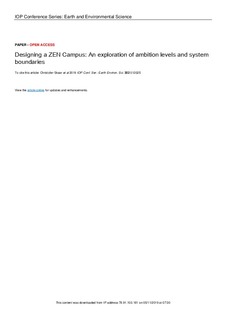| dc.contributor.author | Skaar, Christofer | |
| dc.contributor.author | Solli, Christian | |
| dc.contributor.author | Vevatne, Jonas | |
| dc.date.accessioned | 2019-11-05T16:08:33Z | |
| dc.date.available | 2019-11-05T16:08:33Z | |
| dc.date.created | 2019-11-05T08:32:18Z | |
| dc.date.issued | 2019 | |
| dc.identifier.issn | 1755-1307 | |
| dc.identifier.uri | http://hdl.handle.net/11250/2626736 | |
| dc.description.abstract | The Norwegian University of Science and Technology (NTNU) is gathering from dispersed locations to one central campus at Gløshaugen, requiring an estimated 92 000 m2 new buildings and upgrading 45 000 m2 of existing buildings. NTNU has high environmental ambitions for the new campus, including zero-emission ambitions. This paper explores system boundary definitions and ambition levels in a Zero Emission Neighbourhood (ZEN) context. A key element is a plus energy campus that provides a surplus of renewable energy in the operational phase, that can compensate the carbon footprint of buildings, infrastructure and mobility. Preliminary energy and carbon analyses of the campus have been performed A key result is an overview of design choices and methodology choices for concept stage calculations for a zero-emission campus. Six system boundaries have been defined, with the production to consumption ratio varying from 19 % to 132 %. The lowest includes all buildings, the highest includes production from all buildings, but consumption only from new and renovated buildings. The main finding is that it is possible to realise a plus energy campus for new and renovated buildings, but not including non-renovated buildings. A plus energy campus requires a combination of PV and seasonal energy storage. | nb_NO |
| dc.language.iso | eng | nb_NO |
| dc.publisher | IOP Publishing Ltd. | en |
| dc.relation.ispartof | 1st Nordic conference on Zero Emission and Plus Energy Buildings | |
| dc.rights | CC BY 3.0 | * |
| dc.rights.uri | https://creativecommons.org/licenses/by/3.0/ | * |
| dc.title | Designing a ZEN Campus: An exploration of ambition levels and system boundaries | nb_NO |
| dc.type | Conference object | nb_NO |
| dc.type | Journal article | nb_NO |
| dc.type | Peer reviewed | nb_NO |
| dc.description.version | publishedVersion | nb_NO |
| dc.rights.holder | © The authors | nb_NO |
| dc.subject.nsi | VDP::Teknologi: 500 | nb_NO |
| dc.source.volume | 352 | nb_NO |
| dc.source.journal | IOP Conference Series: Earth and Environmental Science (EES) | nb_NO |
| dc.identifier.doi | 10.1088/1755-1315/352/1/012025 | |
| dc.identifier.cristin | 1744017 | |
| dc.relation.project | Norges forskningsråd: 257660 | nb_NO |
| cristin.unitcode | 7401,30,40,0 | |
| cristin.unitname | Arkitektur, byggematerialer og konstruksjoner | |
| cristin.ispublished | true | |
| cristin.fulltext | original | |
| cristin.qualitycode | 1 | |

